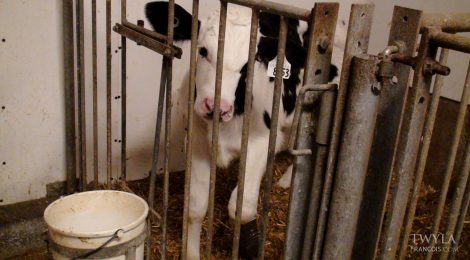
DRAFT NFACC VEAL CODE ALLOWS CONTINUED USE OF VEAL CRATES
The National Farm Animal Care Council (NFACC) has released its draft update to the Recommended Code of Practice for the Care and Handling of Veal Cattle. The previous code was published in 1998. Our greatest concern with the draft update is the continued allowance of the use of solitary crates for veal calves and the acceptance of tethering until 2020.
NFACC is accepting comments from the public until February 14. Please click here to submit your comments.
Here are our areas of greatest concern along with our suggested additions.
2.2 Assessing Calf Health at Purchasing
Calves under 10 days of age must never be transported.
2.3 Managing Calves Upon Arrival
Calves must only be handled with gentle, slow movements. Calves must never be lifted by their tails, ears or heads. Calves must never be thrown or dragged.
Electric prods must never be used on calves.
3.1 Housing Systems
Calves must never be confined to solitary crates, regardless of age. All calves must be group-housed upon arrival and groups must remain stable and not be mixed.
Tethering must be prohibited immediately.
Existing stalls (in use until 2020) must allow calves to turn around and be in contact with other calves.
3.4 Flooring and Bedding
Floors must be designed as not to cause injury or suffering to calves standing or lying on them. They must be suitable for the size and weight of the calves and form a rigid, even and stable surface. The lying area must be deep-bedded.
4.1 Feed and Water
Calves fed a liquid diet must be fed via a teat.
All calves must be fed according to their physiological needs. In particular, their feed must contain sufficient iron and a minimal daily ration of fibrous food must be provided to each calf over 2 weeks old.
All calves must be fed at least twice a day and must have access to food at the same time as the others in the group.
4.2 Milk Feeding
Calves must be allowed to stay with their mothers for a minimum of 8 weeks. Suckling herds where calves are not removed from their mothers should be encouraged.
4.2.2 Iron Deficiency Anemia
Calves fed a liquid diet must be fed via a teat.
All calves must be fed according to their physiological needs. In particular, their feed must contain sufficient iron.
4.2.3 Weaning
Calves must not be weaned until they are at least 8 weeks of age.
5.2 Handling and Moving Cattle
Calves must never be lifted by their tails, ears or heads. Calves must not be thrown or dragged.
Electric prods must never be used on calves, regardless of their age. Electric prods must never be allowed in barns or during loading and unloading in transport.
5.6 Disbudding, Dehorning and Castration
Disbudding, dehorning and castration should be prohibited.
6.3 Sick or Injured Cattle
Sick, injured or diseased cattle must receive prompt treatment and nursing care, as well as pain relief in the form of non-steroidal anti-inflammatory drugs.
6.3.2 Diarrhea
Tube feeding must never be allowed unless done by a practicing veterinarian.
7.2 On Farm Loading and Unloading
Calves under 10 days of age must never be transported.
Electric prods must never be used on calves.
Calves must never be lifted by their tails, ears or heads. Calves must never be thrown or dragged.


